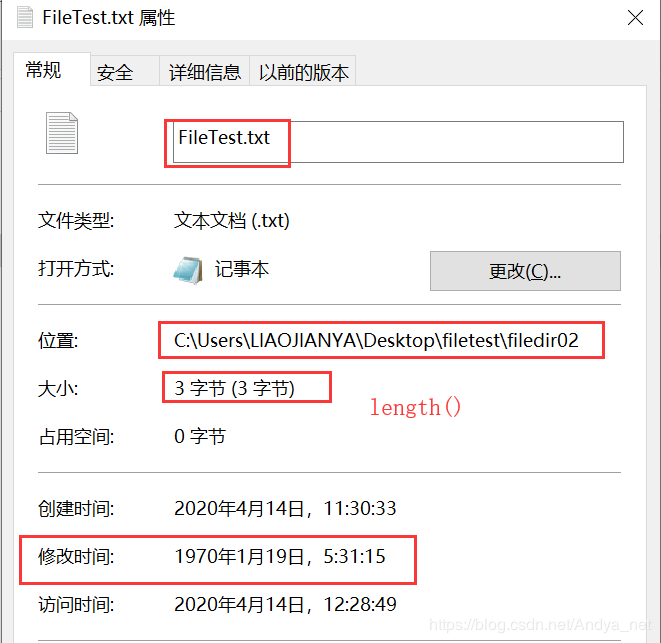Java—File类详解及实践
File类是 java.io 包下代表 与平台无关 的 文件和目录 。File可以新建、删除、重命名文件和目录,但是不能访问文件内容本身,如果需要访问内容的话,需要通过 输入/输出流 进行访问。
File类可以使用文件路径字符串创建File实例,路径既可以是绝对路径,也可以是相对路径。一般相对路径的话是由系统属性 user.dir 指定,即为Java VM所在路径。
File类常用构造器
/**
* Creates a new <code>File</code> instance by converting the given
* pathname string into an abstract pathname. If the given string is
* the empty string, then the result is the empty abstract pathname.
*
* @param pathname A pathname string
* @throws NullPointerException
* If the <code>pathname</code> argument is <code>null</code>
*/
public File(String pathname) {
if (pathname == null) {
throw new NullPointerException();
}
this.path = fs.normalize(pathname);
this.prefixLength = fs.prefixLength(this.path);
}
复制代码
File类常用方法
-
public String getName():返回File对象锁表示的文件名或者目录名(若为目录,返回的是最后一级子目录)。 -
public String getParent():返回此File对象所对应的路径名,返回String类型。 -
public File getParentFile():返回此File对象的父目录,返回File类型。 -
public String getPath():返回此File对象所对应的路径名,返回String类型。 -
public boolean isAbsolute():判断File对象所对应的文件或者目录是否是绝对路径。 -
public String getAbsolutePath():返回此File对象所对应的绝对路径,返回String类型。 -
public String getCanonicalPath() throws IOException: -
public File getCanonicalFile() throws IOException: -
public File getAbsoluteFile():返回此File对象所对应的绝对路径,返回File类型。 -
public boolean canRead():判断此File对象所对应的文件或目录是否可读。 -
public boolean canWrite():判断此File对象所对应的文件或目录是否可写。 -
public boolean canExecute():判断此File对象所对应的文件或目录是否可执行。 -
public boolean exists():判断此File对象所对应的文件或目录是否存在。 -
public boolean isDirectory():判断此File对象是否为目录。 -
public boolean isFile():判断此File对象是否为文件。 -
public boolean isHidden():判断此File对象是否为隐藏。 -
public long lastModified():返回该File对象最后修改的时间戳,我们可以通过SimpleDateFormat simpleDateFormat = new SimpleDateFormat("yyyy-MM-dd HH:mm:ss");进行格式化为时间日期展示。 -
public boolean setLastModified(long time):设置该File对象最后修改的时间戳。 -
public long length():返回该File对象的文件内容长度。 -
public boolean createNewFile() throws IOException:当此File对象所对应的文件不存在时,该方法会新建一个该File对象所指定的新文件,如果创建成功,返回true;否则,返回false。 -
public boolean delete():删除File对象所对应的文件或目录,删除成功,返回true;否则,返回false。 -
public void deleteOnExit():Requests that the file or directory denoted by this abstract pathname be deleted when the virtual machine terminates.意思就是在VM关闭的时候,删除该文件或者目录,不像delete()方法一调用就删除。一般用于临时文件比较合适。 -
public String[] list():列出File对象的所有子文件名和路径名,返回的是String数组。 -
public File[] listFiles():列出File对象的所有子文件吗和路径名,返回的是File数组。 -
public boolean mkdir():创建目录,并且只能在已有的父类下面创建子类,如果父类没有,那么就无法创建子类。 -
public boolean mkdirs():也是创建目录,而且可以在父文件夹不存在的情况下,创建子文件夹,顺便将父文件夹也创建了,递归创建。 -
public boolean renameTo(File dest):重命名此File对象所对应的文件或目录,如果重命名成功,则返回true;否则,返回false。 -
public boolean setReadOnly():设置此File对象为只读权限。 -
public boolean setWritable(boolean writable, boolean ownerOnly):写权限设置,writable如果为true,允许写访问权限;如果为false,写访问权限是不允许的。ownerOnly如果为true,则写访问权限仅适用于所有者;否则它适用于所有人。 -
public boolean setWritable(boolean writable): 底层实现是:通过setWritable(writable, true)实现,默认是仅适用于文件或目录所有者。
public boolean setWritable(boolean writable) {
return setWritable(writable, true);
}
复制代码
public boolean setReadable(boolean readable, boolean ownerOnly) public boolean setReadable(boolean readable)
public boolean setReadable(boolean readable) {
return setReadable(readable, true);
}
复制代码
public boolean setExecutable(boolean executable, boolean ownerOnly) public boolean setExecutable(boolean executable)
public boolean setExecutable(boolean executable) {
return setExecutable(executable, true);
}
复制代码
-
public static File[] listRoots():列出系统所有的根路径,可以直接通过File类进行调用。 -
public long getTotalSpace():返回总空间大小,默认单位为字节。 -
public long getFreeSpace():Returns the number of unallocated bytes in the partition,返回未被分配空间大小,默认单位为字节。 -
public long getUsableSpace():Returns the number of bytes available to this virtual machine on the partition,返回可用空间大小,默认单位为字节。 -
public Path toPath():返回该File对象的Path对象。 -
public static File createTempFile(String prefix, String suffix) throws IOException:在默认存放临时文件目录中,创建一个临时空文件。可以直接使用File类来调用,使用给定前缀、系统生成的随机数以及给定后缀作为文件名。prefix至少3字节长。如果suffix设置为null,则默认后缀为.tmp。 -
public static File createTempFile(String prefix, String suffix, File directory):在指定的临时文件目录directort中,创建一个临时空文件。可以直接使用File类来调用,使用给定前缀、系统生成的随机数以及给定后缀作为文件名。prefix至少3字节长。如果suffix设置为null,则默认后缀为.tmp。
常用方法示例
1)运行主类
package com.example.andya.demo;
import org.springframework.boot.SpringApplication;
import org.springframework.boot.autoconfigure.SpringBootApplication;
import java.io.File;
import java.io.IOException;
import java.net.URI;
import java.nio.file.Path;
import java.text.SimpleDateFormat;
@SpringBootApplication
public class DemoApplication {
public static void main(String[] args) throws IOException {
File file = new File("C://Users//LIAOJIANYA//Desktop//filetest//filedir02//FileTest.txt");
System.out.println("getName(): " + file.getName());
System.out.println("getParent(): " + file.getParent());
System.out.println("getParentFile(): " + file.getParentFile());
System.out.println("getAbsolutePath(): " + file.getAbsolutePath());
System.out.println("getAbsoluteFile(): " + file.getAbsoluteFile());
System.out.println("getAbsoluteFile().getParent(): " + file.getAbsoluteFile().getParent());
System.out.println("getPath(): " + file.getPath());
System.out.println("isAbsolute(): " + file.isAbsolute());
System.out.println("getCanonicalPath(): " + file.getCanonicalPath());
System.out.println("getCanonicalFile(): " + file.getCanonicalFile());
System.out.println("canRead(): " + file.canRead());
System.out.println("canWrite(): " + file.canWrite());
System.out.println("canExecute(): " + file.canExecute());
System.out.println("exists(): " + file.exists());
System.out.println("isDirectory(): " + file.isDirectory());
System.out.println("isFile(): " + file.isFile());
System.out.println("isHidden(): " + file.isHidden());
System.out.println(file.setLastModified(1546275661));
SimpleDateFormat simpleDateFormat = new SimpleDateFormat("yyyy-MM-dd HH:mm:ss");
System.out.println("lastModified(): " + simpleDateFormat.format(file.lastModified()));
//在里面写了"123"这三个数字
System.out.println("length(): " + file.length());
File newFile01 = new File("C://Users//LIAOJIANYA//Desktop//filetest//filedir02//FileTest1.txt");
newFile01.createNewFile();
newFile01.delete();
File newDir1 = new File("C://Users//LIAOJIANYA//Desktop//filetest//filedir02//dir1");
System.out.println("mkdir(): " + newDir1.mkdir());
File newDir2 = new File("C://Users//LIAOJIANYA//Desktop//filetest//filedir02//dir2//dir2-1");
System.out.println("mkdirs(): " + newDir2.mkdirs());
String[] fileList = file.getParentFile().list();
System.out.println("========上一级目录下的所有文件和路径=========");
for (String fileName : fileList) {
System.out.println(fileName);
}
System.out.println("file重命名:" + file.renameTo(new File("C://Users//LIAOJIANYA//Desktop//filetest//filedir02//FileTest.txt")));
System.out.println("========上一级目录下的所有文件和目录=========");
File[] files = file.getParentFile().listFiles();
for (File fileName : files) {
System.out.println(fileName.getName());
}
System.out.println("canRead(): " + file.canRead());
//人为改为不可写
System.out.println("setWritable(): " + file.setWritable(false, false));
System.out.println("canWrite(): " + file.canWrite());
System.out.println("canExecute(): " + file.canExecute());
System.out.println("========相对路径=========");
//默认相对路径是user.dir即为当前工程所在位置
System.out.println("user.dir:" + System.getProperty("user.dir"));
File newFile = new File("test.txt");
System.out.println("newFile文件是否存在:" + newFile.exists());
newFile.createNewFile();
System.out.println("新建newFile文件后是否存在:" + newFile.exists() + ", 路径为:" + newFile.getAbsolutePath());
System.out.println("getName(): " + newFile.getName());
System.out.println("getParent(): " + newFile.getParent());
System.out.println("getParentFile(): " + newFile.getParentFile());
System.out.println("getAbsolutePath(): " + newFile.getAbsolutePath());
System.out.println("getAbsoluteFile(): " + newFile.getAbsoluteFile());
System.out.println("getAbsoluteFile().getParent(): " + newFile.getAbsoluteFile().getParent());
System.out.println("getPath(): " + newFile.getPath());
System.out.println("isAbsolute(): " + newFile.isAbsolute());
System.out.println("getCanonicalPath(): " + newFile.getCanonicalPath());
System.out.println("getCanonicalFile(): " + newFile.getCanonicalFile());
URI uri = newFile.toURI();
System.out.println("URI:" + uri.toString());
File[] listRoots = File.listRoots();
System.out.println("========系统根目录下的所有文件和路径=========");
for (File root : listRoots) {
System.out.println(root);
}
System.out.println("getTotalSpace(): " + file.getTotalSpace()/1024/1024/1024 + " G");
System.out.println("getFreeSpace(): " + file.getFreeSpace()/1024/1024/1024 + " G");
System.out.println("getUsableSpace(): " + file.getUsableSpace()/1024/1024/1024 + " G");
Path path = file.toPath();
System.out.println("Path: " + path);
SpringApplication.run(DemoApplication.class, args);
}
}
复制代码
2)运行结果:
getName(): FileTest.txt getParent(): C:/Users/LIAOJIANYA/Desktop/filetest/filedir02 getParentFile(): C:/Users/LIAOJIANYA/Desktop/filetest/filedir02 getAbsolutePath(): C:/Users/LIAOJIANYA/Desktop/filetest/filedir02/FileTest.txt getAbsoluteFile(): C:/Users/LIAOJIANYA/Desktop/filetest/filedir02/FileTest.txt getAbsoluteFile().getParent(): C:/Users/LIAOJIANYA/Desktop/filetest/filedir02 getPath(): C:/Users/LIAOJIANYA/Desktop/filetest/filedir02/FileTest.txt isAbsolute(): true getCanonicalPath(): C:/Users/LIAOJIANYA/Desktop/filetest/filedir02/FileTest.txt getCanonicalFile(): C:/Users/LIAOJIANYA/Desktop/filetest/filedir02/FileTest.txt canRead(): true canWrite(): false canExecute(): true exists(): true isDirectory(): false isFile(): true isHidden(): false true lastModified(): 1970-01-19 05:31:15 length(): 3 mkdir(): false mkdirs(): false ========上一级目录下的所有文件和路径========= dir1 dir2 FileTest.txt file重命名:true ========上一级目录下的所有文件和目录========= dir1 dir2 FileTest.txt canRead(): true setWritable(): true canWrite(): false canExecute(): true ========相对路径========= user.dir:C:/DATA/selfcode newFile文件是否存在:true 新建newFile文件后是否存在:true, 路径为:C:/DATA/selfcode/test.txt getName(): test.txt getParent(): null getParentFile(): null getAbsolutePath(): C:/DATA/selfcode/test.txt getAbsoluteFile(): C:/DATA/selfcode/test.txt getAbsoluteFile().getParent(): C:/DATA/selfcode getPath(): test.txt isAbsolute(): false getCanonicalPath(): C:/DATA/selfcode/test.txt getCanonicalFile(): C:/DATA/selfcode/test.txt URI:file:/C:/DATA/selfcode/test.txt ========系统根目录下的所有文件和路径========= C:/ getTotalSpace(): 237 G getFreeSpace(): 41 G getUsableSpace(): 41 G Path: C:/Users/LIAOJIANYA/Desktop/filetest/filedir02/FileTest.txt 复制代码
3)结果的一些验证:a)文件长度以及修改时间

b)设置不可写后:

b)磁盘大小

c)user.dir路径

createTempFile临时文件创建示例
1)运行主类
File file2 = new File("C://Users//LIAOJIANYA//Desktop//filetest//filedir01");
File tmp01 = file2.createTempFile("tmp01", ".tmp");
File tmp02 = file2.createTempFile("tmp02", ".tmp", file2);
tmp02.deleteOnExit();
File tmp03 = File.createTempFile("tmp03", null);
System.out.println("tmp01: " + tmp01.getAbsolutePath());
System.out.println("tmp02: " + tmp02.getAbsolutePath());
System.out.println("tmp03: " + tmp03.getAbsolutePath());
复制代码
2)运行结果
tmp01: C:/Users/LIAOJI~1/AppData/Local/Temp/tmp01870328708927314810.tmp tmp02: C:/Users/LIAOJIANYA/Desktop/filetest/filedir01/tmp023046960943790159256.tmp tmp03: C:/Users/LIAOJI~1/AppData/Local/Temp/tmp032224782289258299121.tmp 复制代码
3)查看结果: a)默认临时文件存放地址:

b)指定临时文件存放地址:

deleteOnExit()
方法。
FilenameFilter文件过滤器示例
public String[] list(FilenameFilter filter) 方法的使用。 1)运行主类
public class DemoApplication {
public static void main(String[] args) {
File file = new File("C://Users//LIAOJIANYA//Desktop//filetest//filedir02//");
String[] nameArr = file.list(((dir, name) -> name.endsWith(".doc")));
for (String name : nameArr) {
System.out.println(name);
}
}
}
复制代码
2)运行结果:
文件01.doc 复制代码
3)验证:

.doc
结尾的文件。
正文到此结束
热门推荐
相关文章
Loading...










![[HBLOG]公众号](https://www.liuhaihua.cn/img/qrcode_gzh.jpg)

